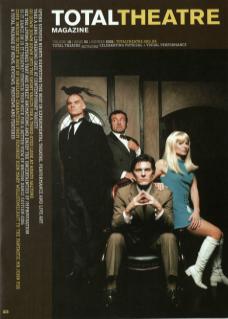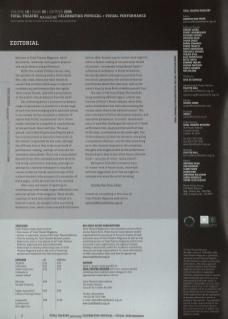Welcome to Total Theatre Magazine, which documents, celebrates and supports physical and visual theatre and performance.
Within the context of these various roles, the question of reviewing work is often raised. Who, why, what, where and when should we review? And are there better ways to report on contemporary performance than the regular short-review format, read with a presumption of the writer's critical distance from the work?
Our continuing policy is to present as broad a range of approaches as possible to a broad range of work from both emerging and established artists. In our reviews section we publish a selection of reports that fit the conventional short-review model, intended as a snapshot of a performance at one particular place and time. The usual ground-rule is that the person writing the piece has no professional or personal connections to the artist(s) responsible for the work, although the difficulty here is that in the small world of performance-making, overlaps of some sort are sometimes unavoidable. This is not a new problem: Kenneth Tynan often reviewed work with which he had strong connections, and many years ago an attempt by a national newspaper to stop book reviews written by friends and associates of the authors resulted in the prospect of a succession of blank pages, so the decision had to be reversed.
Other ways and means of reporting on contemporary work include longer reflections in the editorial section of the magazine. These include responses to work seen within the context of a festival or event, an example in this issue being ‘Borderline Cases’, which circles around British Dance Edition 2006. Another way to ‘review' work might be within a feature looking at one particular strand of practice – an example being Edward Taylor's reflection on walkabout in ‘Street Animations’. We also document contemporary practice from the artist's perspective with article written by practitioners about their own work, such as the artist's diary by Anna Birch on Wollstonecraft Live!.
One item in this issue breaks the mould by being something different again – a three-way (re)view of Shunt's Amato Saltone, which after some consideration has been placed among the reviews rather than in the editorial section. This piece attempts to find an alternative response, and equivalent perspective, to a multi-dimensional piece of work that challenges the notion of a fixed performance text, by giving three points of view of the show, as witnessed on the same night. Two of the witnesses are there as reviewers, one giving a considered reflection, and the other presenting an in-the-moment response to the sensations, thoughts and images evoked by the performance. The third eye is that of one of the Shunt collective itself – so a case of ‘artist, review thyself'.
We hope to find other innovative ways to 'review' work in future issues, and would welcome suggestions as to how we might re-evaluate and renew the art of reviewing!

